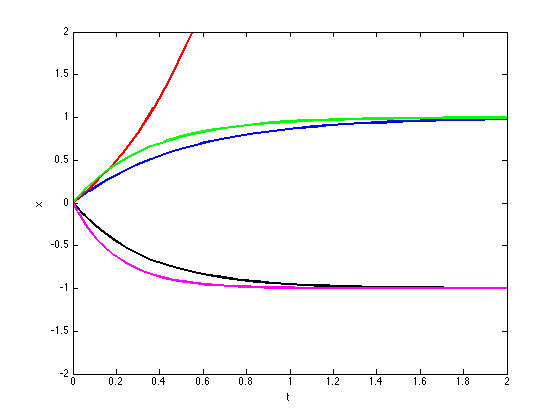For problem 2.9, if you do it correctly you should end up with two expressions:
- r(t) = - k t + c1
- L(t) = -2 k t+ c2
where r is the radius of the sphere and L is the length of the side of the cube.
Someone (1) pointed out in office hours, correctly, that just because L decreases twice as fast as r doesn't mean the cube shrinks faster than the sphere. If r started at 1 and L started at 10, then it would take one second for r to go to zero and 5 second for L to go to zero.
Someone else (2) pointed out, correctly, that for the same volume, the equivalent length is about 1.6 times bigger, so that if it shrinks twice as fast, then the cube will disappear sooner. The corresponding and equivalent way I think about it is that if we take the same starting volume, V, then c1 = ((3 V)/(4 \pi))^(1/3) and c2 = V^(1/3). So the time it would take r to get to zero would be c1/k = 0.62 V^(1/3)/k and the time it would take L to get to zero would be c2/(2 k) = 0.5 V^(1/3)/k. So the cube disappears sooner.
Someone (1) was ok with that, but had the following question/quasi-objection. "Well, you just chose to use L, but that is not the same as a radius. How do you know that if you chose another length measure that you will get the same result?" Examples of this would be something like the distance from the center of the cube to a corner, or perhaps the perimeter around the whole thing, or a spiral out from the center to an edge, or whatever. And for the sphere we could have used the circumference instead of the radius. This is actually a great question because there is no "right" way to choose a characteristic length for a geometric object. We typically chose the radius and length of the side, so they are standard and maybe the most convenient, but they aren't necessarily "right" in any sense.
I think Someone (1) also specifically asked how we know that another length measure for the cube compared to the radius of the sphere might not be greater than 2, in which case it would take longer to evaporate (remember for the length of the side, the equivalent side is 1.6 times longer, but because 2 > 1.6 it evaporates sooner). The answer to that is that if you change the characteristic length of the cube, the 2 times the k will also change because that comes from the relationship between dV/dL and the surface area. So if yo choose a different characteristic length of the cube, you won't get "-2 k" in the solution for how that characteristic length evolves.
Someone (1) may not have literally meant "2" but rather whatever number multiplies k, however. The answer to that, if I am still anywhere close to his question, is that the rate of evaporation is a relationship between the volume and surface area and is an intrinsic geometric property, which is independent of whatever number we choose to characterize the volume and surface area. If we prove that the cube shrinks faster than the sphere for a given characteristic length, and the fundamental relationship that the rate of change of volume is proportional to surface area which is a geometric relationship independent of how we choose to represent it, it will be impossible to find another length that will give a different answer.
The reason I typed so much is that this is fundamental to science and mechanics. Nature doesn't care where we put a coordinate system or how we represent a volume or surface area, so we better get the same answer independent of how we put coordinates on the system, which is generally called "coordinate invariance." A sort of related notion gave rise to Einstein's special theory of relativity, which is that mechanics are the same in systems translating with constant velocity and the speed of light is a also a constant.
